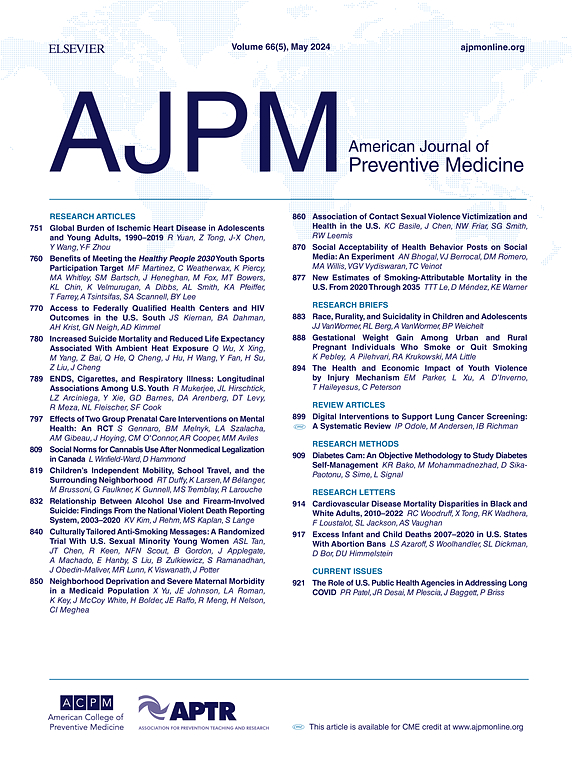母亲抑郁与父亲产后抑郁的时间关系。
IF 4.3
2区 医学
Q1 MEDICINE, GENERAL & INTERNAL
引用次数: 0
摘要
父亲产后抑郁(PPPD)可能影响28%的父亲,但其与母亲产后抑郁的时间相关性尚不清楚。本研究旨在量化产后抑郁与PPPD之间的时间相关性,同时考虑母亲的抑郁史和其他临床因素。方法:这项回顾性队列研究的数据来自2008年至2019年科罗拉多州凯撒医疗机构的健康记录。该队列包括活产怀孕的父亲和母亲。诊断代码在产后12个月内确定了产后抑郁症。采用治疗加权逆概率的互补对数-对数模型,根据产妇抑郁史分层,估计产后抑郁对PPPD的相对风险(RR)。在2022年至2024年间进行了统计分析。结果:样本包括15,257对父母二对,其中父母双方都没有产后抑郁症病史的怀孕人数为19,352人。在这些孕妇中,326例诊断为PPPD(1.7%), 1731例诊断为产后抑郁症(8.9%)。PPPD在有产后抑郁的二联体中更常见(3.0%),而在没有产后抑郁的二联体中更常见(1.6%)。产后抑郁与PPPD增加81%相关(RR=1.81;如果母亲没有抑郁史,95% CI为1.14 ~ 2.87)。然而,如果母亲有抑郁史,则没有观察到这种关联。结论:在一组活产妊娠的父母组中,母亲产后抑郁与PPPD升高有关,但仅在母亲没有抑郁史的情况下。研究结果强调了为父亲开发抑郁症筛查工具的必要性,这些工具要考虑到父母双方的风险因素。本文章由计算机程序翻译,如有差异,请以英文原文为准。
Temporal Association Between Maternal Depression and Paternal Postpartum Depression
Introduction
Paternal postpartum depression may affect 28% of fathers, but its temporal association with maternal postpartum depression is not well understood. This study aimed to quantify the temporal association between maternal postpartum depression and paternal postpartum depression, considering mother's depression history and other clinical factors.
Methods
Data for this retrospective cohort study were obtained from Kaiser Permanente Colorado health records between 2008 and 2019. The cohort included father–mother dyads having live-birth pregnancies. Diagnostic codes identified postpartum depression during the 12 months after childbirth. Complementary log–log models with inverse probability of treatment weighting estimated the relative risk of paternal postpartum depression by maternal postpartum depression, stratified by maternal depression history. Statistical analyses were performed between 2022 and 2024.
Results
The sample included 15,257 father–mother dyads contributing 19,352 pregnancies, in which neither parent had a history of postpartum depression. Among these pregnancies, 326 paternal postpartum depression diagnoses (1.7%) and 1,731 maternal postpartum depression diagnoses (8.9%) were identified. Paternal postpartum depression was more common in dyads with maternal postpartum depression (3.0%) than in dyads without (1.6%). Maternal postpartum depression was associated with an 81% increase in paternal postpartum depression (relative risk=1.81; 95% CI=1.14, 2.87) if the mother had no history of depression. However, no association was observed if the mother had a history of depression.
Conclusions
Among a cohort of father–mother dyads having live-birth pregnancies, maternal postpartum depression was associated with increased paternal postpartum depression but only if the mother had no history of depression. Study findings highlight the need to develop depression screening tools for fathers that consider risk factors for both parents.
求助全文
通过发布文献求助,成功后即可免费获取论文全文。
去求助
来源期刊

American Journal of Preventive Medicine
医学-公共卫生、环境卫生与职业卫生
CiteScore
8.60
自引率
1.80%
发文量
395
审稿时长
32 days
期刊介绍:
The American Journal of Preventive Medicine is the official journal of the American College of Preventive Medicine and the Association for Prevention Teaching and Research. It publishes articles in the areas of prevention research, teaching, practice and policy. Original research is published on interventions aimed at the prevention of chronic and acute disease and the promotion of individual and community health.
Of particular emphasis are papers that address the primary and secondary prevention of important clinical, behavioral and public health issues such as injury and violence, infectious disease, women''s health, smoking, sedentary behaviors and physical activity, nutrition, diabetes, obesity, and substance use disorders. Papers also address educational initiatives aimed at improving the ability of health professionals to provide effective clinical prevention and public health services. Papers on health services research pertinent to prevention and public health are also published. The journal also publishes official policy statements from the two co-sponsoring organizations, review articles, media reviews, and editorials. Finally, the journal periodically publishes supplements and special theme issues devoted to areas of current interest to the prevention community.
 求助内容:
求助内容: 应助结果提醒方式:
应助结果提醒方式:


